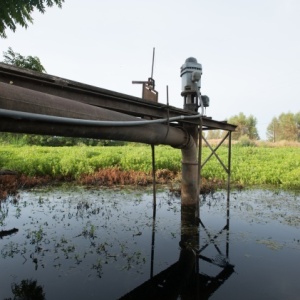
In this paper by researchers from Germany, Kenya, Australia and Sweden, a modeling approach is taken to ascertain the efficacy of applying improved water management techniques on a large scale to increase yields to help meet global demand for food.
The researchers considered a wide-range of techniques on varying scales (e.g. low-tech approaches used by smallholders vs. large-scale high-tech options for industrial applications), estimating the amount of water that could be saved and the yield increases that could be produced (specifically where current yields are much lower than potential due to water limitations - called the “water gap”), under different future climate scenarios. They limited their modeling to scenarios in which no further land use change occurs and pressure on water resources does not increase (i.e. no agricultural expansion). The modelling took the form of a creating a dynamic global bio-agrosphere model - that is, a detailed model which seeks to encapsulate all the salient details of the biosphere and all agricultural activities - into which the different water management strategies could be incorporated and the outcome of doing so assessed. The researchers examined four water management techniques both individually and in combination to produce an integrated management plan.
The four techniques were:
- Ex situ water harvesting: that is, concentrating, collecting and storing surface run-off to be reapplied to cropland as supplementary irrigation.
- In situ water harvesting: that is, small-scale management of fields, through e.g. micro-catchments system (i.e. changing the lie of the land to retain water through, e.g. terracing) or mulching, to minimise run-off and soil evaporation.
- Soil moisture conservation: similarly to in situ water harvesting, this is a method for reducing soil evaporation through mulching and conservation tillage.
- Irrigation improvements and expansion with saved water: that is, increasing the efficiency of surface, sprinkler and drip irrigation systems through technological improvements.
The key findings of the paper were:
- Integrated crop water management could increase kcal production globally by up to 41% and yields by up to 56% (depending on the scenario - i.e. the specific conditions of the model).
- Some of the management techniques that have great potential for reducing water use may however not significantly improve production directly on the affected farmland.
- This saved water can in turn be used to expand irrigation onto currently rain-fed cropland allowing for increases in overall production.
- Soil moisture conservation was shown to be particularly effective on rainfed cropland.
- The impact of climate change on crops and their water use is highly uncertain but thought to be largely adverse in nature.
The authors conclude that integrated crop water management strategies across all global scales have significant potential to help intensify agriculture in light of the challenges of climate change, but that it can only be a part of the solution, as they have assumed no further growth in demand for land or pressure on water resources.
Abstract
As planetary boundaries are rapidly being approached, humanity has little room for additional expansion and conventional intensification of agriculture, while a growing world population further spreads the food gap. Ample evidence exists that improved on-farm water management can close water-related yield gaps to a considerable degree, but its global significance remains unclear. In this modeling study we investigate systematically to what extent integrated crop water management might contribute to closing the global food gap, constrained by the assumption that pressure on water resources and land does not increase. Using a process-based bio-/agrosphere model, we simulate the yield-increasing potential of elevated irrigation water productivity (including irrigation expansion with thus saved water) and optimized use of in situ precipitation water (alleviated soil evaporation, enhanced infiltration, water harvesting for supplemental irrigation) under current and projected future climate (from 20 climate models, with and without beneficial CO2 effects). Results show that irrigation efficiency improvements can save substantial amounts of water in many river basins (globally 48% of non-productive water consumption in an ‘ambitious’ scenario), and if rerouted to irrigate neighboring rainfed systems, can boost kcal production significantly (26% global increase). Low-tech solutions for small-scale farmers on water-limited croplands show the potential to increase rainfed yields to a similar extent. In combination, the ambitious yet achievable integrated water management strategies explored in this study could increase global production by 41% and close the water-related yield gap by 62%. Unabated climate change will have adverse effects on crop yields in many regions, but improvements in water management as analyzed here can buffer such effects to a significant degree.
Citation
J Jägermeyr, D Gerten, S Schaphoff, J Heinke, W Lucht, J Rockström (2016). Integrated crop water management might sustainably halve the global food gap. Environmental Research Letters 11 (2), 025002 DOI:10.1088/1748-9326/11/2/025002
Read the original paper here and see further coverage here.
You can find related resources in the Research Library categories on Water, Agricultural and aquatic systems and Technology and keyword categories Irrigation, water management and water stress and scarcity.







Post a new comment »